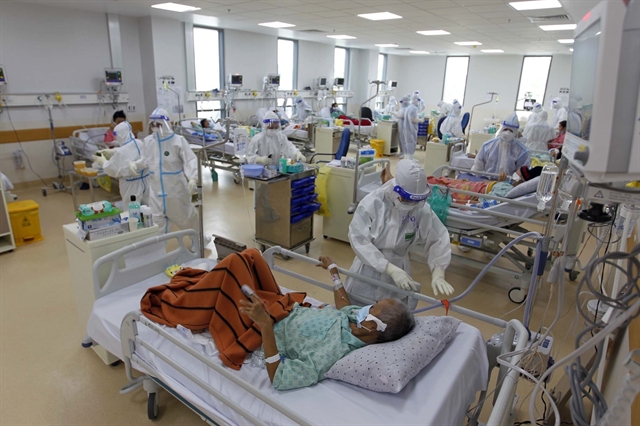 Society
Society


|
| A patient being treated at an Intensive Care Unit in Field Hospital No1 in Việt Trì City, in the northern province of Phú Thọ. — VNA/VNS Photo Diệp Trương |
HÀ NỘI — The Ministry of Health on Wednesday issued guidelines to help localities and agencies get consistency in classifying COVID-19 exposure risks, infection handling and treatment.
Decision No 5525/QD-BYT replaces Decision No 3646/QĐ-BYT, which was issued on July 31 regarding the criteria for classifying the risk of people infected with COVID-19 in the context of the then rapidly increasing COVID-19 infections in HCM City and other southern localities.
However, the inconsistent implementation of risk classification and treatment, isolation, and hospital transfer among localities is affecting the effectiveness of pandemic prevention and control. Therefore, the ministry has adjusted the criteria and orientation of treatment, isolation and treatment to fit with the current situation. The new guidelines will be applied in all provinces and cities nationwide.
According to the new guidelines, people infected with COVID-19 in Việt Nam are divided into four groups – low risk, medium risk, high risk and very high risk.
The low-risk group are people aged between three months and 49 years old, with no underlying diseases or abnormal signs of health, and who have been fully vaccinated against the COVID-19 and have a SpO2 of 97 per cent or more.
People in this group are allowed to isolate at home, if eligible according to regulations. Local healthcare centres, medical staff and volunteers will monitor and manage these infected people and decide to transfer them to a health facility if their health conditions worsen.
Medical workers will also offer psychological support, nutrition, exercise, continuous health monitoring and risk assessments. At the same time, the infected people will receive home care packages including antiviral drugs, vitamins and necessities.
People in the medium-risk group are; those aged 50-64 years old, without underlying diseases and that have been fully vaccinated; those aged between three months and 49 years old but are yet to receive both doses of vaccine, or who have a fever, cough, sore throat, mild shortness of breath and SpO2 of 97 per cent or more.
This group will be treated at a hospital or at a first-tier COVID-19 treatment facility. If the local first-tier treatment facility is overloaded, community-based treatment may be considered.
According to the guidelines, with the medium-risk group, it is necessary to closely monitor and detect early signs of change, in case the patient needs to be hospitalised or move to a higher tier of COVID-19 facilities.
They will be offered antiviral drugs and symptomatic treatment such as fever reduction, pain relief and cough relief along with physical improvement, nutrition, physical therapy and psychological support.
People at the high-risk group are those aged from 65 who are fully vaccinated; those who have an underlying medical condition and are fully vaccinated; those from 50-64 years old with no underlying disease detected but have not been fully vaccinated; pregnant women or women who have given birth with 42 days; children from under 3 months old; and those with SpO2 of 94-96 per cent.
People in this group will be treated at a second-tier COVID-19 treatment hospital. They must be closely monitored for early detection of worsening health signs and then transferred to a higher tier.
The patients will receive antiretroviral treatment, nutrition, anticoagulant prophylaxis, oxygen support and anti-inflammatory drugs as well as follow-up treatment associated with their underlying disease(s).

|
| An area for seriously-ill COVID-19 patients in an Intensive Care Hospital in HCM City. — VNA/VNS Photo Thanh Vũ |
People in the very high-risk group are those aged 65 or older who have not been fully vaccinated; those who have an underlying medical condition and are not fully vaccinated; those who have an emergency condition; and those with a SpO2 below 94 per cent.
People in this group will be treated at COVID-19 treatment hospital (second and third tiers); COVID-19 Intensive Care Center (based on doctor's orders and the number of beds).
For the very high-risk group, the treatment focuses on breathing support, oxygen supply, HFNC, mechanical ventilation, ECMO, supporting organs with dysfunction (dialysis, heart support, vasomotor etc). They will also receive anti-inflammatory treatment, anticoagulants, antibiotics, physical therapy, rehabilitation and prevention of complications.
They will also receive treatment for their underlying disease(s) and will be transferred to a lower-tier if treatment is effective.
Also in the new guidelines, the Ministry of Health mentions seven principles of COVID-19 treatment, including monitoring and caring for asymptomatic COVID-19 patients and mild cases at home (if all conditions are met).
The second principle is to focus on good treatment for first and second tiers patients, strengthening capacity of emergencies and active resuscitation of severe cases on the upper tiers.
Each facility will arrange at least 'two tiers of treatment' and ensure bed availability in intensive care according to treatment stratification. Moreover, it is important to strengthen connections, consultations, and remote treatment consultations. The upper tiers can direct the lower ones for effective treatment.
"The community, primary health care, and hospitals that collect and treat COVID-19 strictly implement risk classification. However, based on the patient's clinical conditions and the availability of hospital beds, the medical facilities have the right to transfer patients to the correct type of hospital bed based on the situation," noted the Ministry of Health. — VNS




